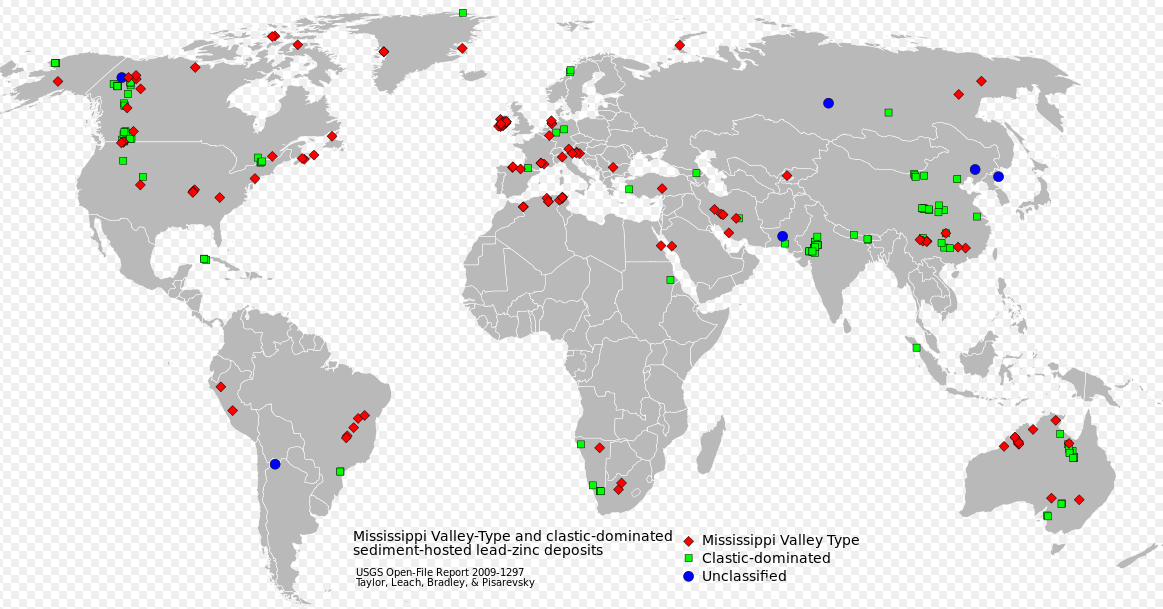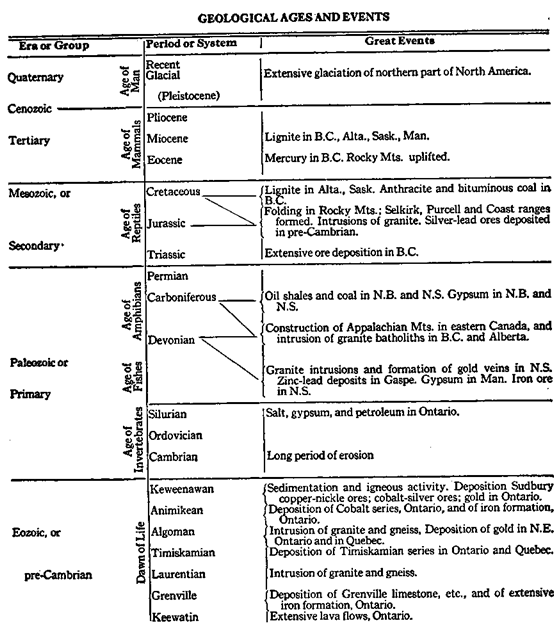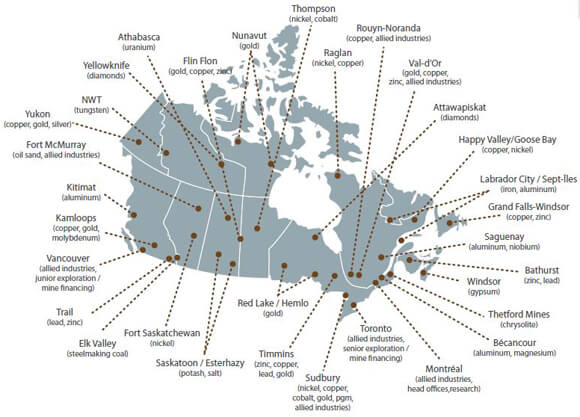Table of Contents
- Silver
- Where to Find Silver in Ontario
- Where to Find Silver in British Columbia
- Where to Find Silver in Yukon
- Lead and Zinc
- Ore Minerals of Lead and Zinc
- Lead-Zinc Deposits near Igneous Intrusions
- Where to Find Pb & Zn In Ontario
- Where to Find Pb & Zn In Quebec
- Lead-Zinc Deposits Independent of Igneous Intrusions
- Where to Find Lead & Zinc In Ontario
- Where to Find Lead & Zinc In Quebec
Silver
The silver production of Canada has been mostly from two classes of deposits:
- those of the Cobalt district where the silver is largely native and associated with cobalt and nickel arsenides; and
- the silver-lead deposits of British Columbia. Silver is likewise produced in considerable quantities in British Columbia from certain gold and copper ores; and some mines, like the old Dolly Varden and the Torbrit in the Cassiar, are essentially silver ore deposits, with very little galena and zinc blende.
Where to Find Silver in Ontario
In Ontario, silver ores have been found in veins in preCambrian sedimentary rocks and Keewatin greenstone, intruded by diabase sills and dikes; silver veins are found also in the diabase. The vein matter in the Cobalt area is mostly calcite, and the silver minerals (native, argentite, dyscrasite and others) are usually associated with cobalt-nickel minerals, of which smaltite and niccolite are the commonest. In South Lorrain, there are ore shoots that are evidently the result of pre-glacial enrichment. The Elk Lake and Gowganda silver veins are in the same formations as those of the Cobalt area. In the Port Arthur region, the veins are similar to those of the Cobalt area, but quartz is more plentiful as a gangue mineral. It is possible that other areas of this kind may be discovered in Ontario. The prospector in the Cobalt country found the pink “bloom,” erythrite, a valuable guide, but sometimes disappointing, as many smaltite veins were found that were barren of silver. Cobalt minerals in small quantities are not uncommon in other districts where no silver is found and the bloom is very conspicuous. Diabase intrusions are numerous in the pre-Cambrian rocks of Ontario, Quebec, and Manitoba. Silver should be searched for in areas where the intruded rocks are of the Cobalt (Animikie) series.
Where to Find Silver in British Columbia
The most important sources of silver in this province are the silver-bearing galena deposits, which contain more or less zinc blende and other sulphides. The separation of zinc from lead with the recovery of the silver was formerly a serious problem in the case of ores high in zinc; but such ores can be treated by modern processes.
Soon after the flotation process became available, the huge silver-lead-zinc orebody of the Sullivan mine became the largest single source of silver in Canada. In prospecting for these ores, it should be remembered that pyrite is a common associate; on weathering, it will leave a rusty capping (limonite).
Zinc blende high in iron also leaves a rusty mass on weathering, but the color may be somewhat reddish. Galena is most likely to weather to cerussite or anglesite, both of which are white, but may be gray at the surface. Thus, the famous old St. Eugene Mine, Moyie, is in a fissure zone consisting of two main fissures roughly parallel, connected by cross veins, which usually join the main veins at a small angle. The best ore bodies were found at the junctions. The vein minerals are coarse-grained galena, zinc blende, pyrite, pyrrhotite, magnetite, and a little copper pyrites. The gangue minerals are pink garnet, actinolite, quartz, and calcite. The sulphides fill the cracks in and between the other minerals, and there is a rusty capping, sometimes several feet deep. The country rock is preCambrian quartzite. At the Slocan Star, silver-bearing galena, zinc blende, tetrahedrite, copper pyrites, pyrite, mispickel, argentite, native silver, and gold occur in a fissure vein, with quartz, siderite, calcite, and barite as a gangue. In the Slocan district, the country rock is slate, intruded by dikes of granite, quartz porphyry, and lamprophyre. Silver-lead deposits are found in sheared zones in crystalline limestone on the east side of Kootenay Lake where the Bluebell mine has become an important producer. At the Dolly Varden Mine, Alice Arm, native silver, argentite, ruby silver, etc., occur with pyrite in quartz veins in gray and green volcanic breccia, near the edge of the great Coast Range batholith of granodiorite (granite with the kind of feldspar characteristic of diorite). The ore is believed to be the result of surface enrichment, as very coarse native silver was found at the surface, and wire silver and thin sheet silver at greater depths. In the Moose and some other properties in this district, the silver value is in galena and tetrahedrite, and is therefore more likely to persist in depth. So far, all the veins in this district have been found in green and gray breccia; purple and red breccia seems to be barren. Surface enrichment is irregular, so that a discovery should be examined as completely as possible by stripping.
Where to Find Silver in Yukon
The great granodiorite batholith extends northward into the Yukon, and, as was expected, ore deposits have been found around its edges in that territory. In the Keno Hill area are two systems of fissure veins of quartz, mineralized with mispickel, galena, zinc blende, manganese, and a silver mineral not identified. The veins cut through schists and quartzite (probably pre-Cambrian), which are intruded by quartz porphyry and granite porphyry. The principal ore shoots are in the transverse veins that cut across the great fault, and especially at the junctions. The galena is high in silver. The veins are easy to locate by galena, manganese, and iron float, usually not far removed from the veins. Formerly it was thought that the high silver values do not persist to great depth: but deep exploration in recent years has shown that the irregular shoots of ore occur as deep as mining has gone. Thus the Keno Hill camp is still expanding and it is likely to have a long life.
Lead and Zinc
Lead and zinc ores are found so often mixed that they are described together. In addition to galena and zinc blende, pyrite is generally present and often in considerable quantities, and copper pyrites is generally present. By weathering, the latter may leave green and blue stains. The ore deposits are of two principal kinds:
- (a) Veins and replacement deposits near igneous intrusions. These are discussed under Silver, as they are generally silver-bearing, and are sometimes very rich in that metal.
- (b) Deposits in sedimentary rocks not intruded by igneous rocks. These are usually not silver-bearing. The deposits are found mostly in limestone and dolomite, also in chert and in limey shale. The ore bodies are in brecciated zones, in crevices (gash veins) or joints enlarged by the dissolving action of water; sometimes scattered in limestone or dolomite along certain lines of stratification; in Ontario and Quebec, they occur frequently in fissure veins, which should be found to persist in depth. The others are shallow deposits. The deposits of Pine Point south of Lake Athabaska are of the shallow, flat bedded type. They are extensive and are likely to become very important producers of lead and zinc.
Ore Minerals of Lead and Zinc
The principal ore minerals are galena and zinc blende, but there may be considerable quantities of cerussite, anglesite, calamine, and smithsonite in the zone of oxidation. Pyrite is usually present, and marcasite nearly always. The rusty weathering of these two minerals may have left an iron cap. The zinc blende weathering is apt to be low in iron and of a light brown, red, or yellow color.

Galena is a conspicuous mineral, usually very easily “spotted,” although occasionally so fine- grained as to appear steel-back (“steel galena”) instead of lead-gray. The carbonate (cerussite) and sulphate (anglesite) are sometimes found in quantity, as a result of oxidation of galena. Zinc blende weathers easily, and, if high in iron, leaves a rusty capping.
Lead-Zinc Deposits near Igneous Intrusions
Examples of the British Columbia and Yukon lead-zinc ore deposits, all of the kind near igneous intrusions are described earlier. The high- temperature minerals, garnet, epidote, pyroxene, biotite, and pyrrhotite, are found in some but not all of these deposits, and the silver and gold values are sometimes great enough to put the ore in the precious metals class. The deposits are fissure veins, contact metamorphic bodies, or sheared and brecciated mineralized zones; they are of a kind that has a good chance of continuing as the depth increases.
Where to Find Pb & Zn In Ontario
Dark colored zinc blende, with pyrite, pyrrhotite, copper pyrites, and a little native copper, irregular lenses in much altered and schisted diorite, is found at Zenith Zinc Mine, Rossport. At Zinc Prospect, near Ruel, occurs a fine-grained mixture of galena and zinc blende with pyrrhotite and copper pyrites in mineralized zones in greenstone and iron formation. Pyrrhotite was first discovered, the galena and zinc blende being found later, as the depth of sinking increased. In Barrie Tp., Frontenac Co., is found galena, zinc blende, pyrite, and copper pyrites with quartz and calcite in stringers and lenses, running with the strike of the country rock, which is crystalline limestone and mica schist. The galena is high in silver; the ore bodies are near granite intrusions. At McKinnon Vein, Steeprock Lake, Atikokan, occurs silver-bearing galena and zinc blende, with pyrite and copper pyrites, in a vein of white, sugary quartz, near contact of greenstone schist with granite. At the Victoria property, Garden River, Algoma, galena with zinc blende, pyrite, and copper pyrites in stringers, grains, and small bunches, is found in green schist; the ore carries gold and silver. Inside the Sudbury copper-nickel basin have been found large deposits of complex ore carrying zinc, lead, copper, gold, and silver, now being developed by Ontario Pyrites Ltd. These deposits are closely associated with a fault running lengthwise of the basin.
Where to Find Pb & Zn In Quebec
In the Anacon (formerly Tetreault) mine at Notre-Dame-des-Anges, Portneuf Co., zinc blende is found with galena, pyrite, pyrrhotite, and copper pyrites, in gash veins in mineralized zones running with the strike of the rocks, in micaceous quartzite and crystalline limestone; garnet, biotite, pyroxene, hornblende, and quartz are the gangue minerals. The ore carries silver and gold. The ore bodies are near igneous intrusions of pyroxenite. At the New Calumet mine on Calumet Island, Ottawa River, zinc blende and silver-bearing galena are found with pyrite, copper pyrites, magnetite, pyrrhotite, and occasionally native silver, in mineralized zones that have gash veins running with the strike of the quartzite, crystalline limestone, and gneiss which form the country rock. The lenses pinch out and take up again both along the surface and vertically. The gangue minerals are quartz, calcite, garnet, etc. There are intrusions of granite and gabbro in the crystalline limestone not far from the ore deposits. Near the ore-zones the quartzite carries much sericite.
In the Val d’Or area of northwestern Quebec a large tonnage of zinc-lead ore has been mined from the Golden Manitou mine. “The orebodies are sulphide replacements in a sericite schist shear zone. The sulphide minerals in the ore are pyrite and sphalerite with minor quantities of galena, tennantite, chalcopyrite, and arsenopyrite. The shear zone is bounded on the north and south by a series of more compact volcanic rocks.” (S. A. J. Hopper, 1948). The ore is not far from a granodiorite batholith.
In Lemieux Township, Gaspé Peninsula, zinc blende and galena with a little pyrite, marcasite, and copper pyrites, occur in veins and crushed zones cutting across the strike of shale and limestone, which are folded, faulted, jointed, and brecciated, and which have been intruded by porphyry and syenite. Gangue minerals are quartz (both white and amethystine), dolomite, ankerite, and calcite. At the surface, there is, in some places, a white coating of zinc silicate (calamine), and zinc carbonate, formed by weathering of zinc blende. Discoveries have been made by finding pieces of float galena, sometimes weathered to a rounded brownish mass, and trenching up-hill from these finds. The vein-outcrops usually show only white or brownish quartz, from which the zinc blende and most if not all of the galena have been weathered out, leaving the quartz in a cellular condition. Where galena has been left in the quartz, it may have a reddish-brown coating. As this part of Quebec escaped glaciation, the veins are often deeply covered with weathered vein material.
Lead-Zinc Deposits Independent of Igneous Intrusions
These are well-defined fissure veins of galena and zinc blende in a gangue of calcite with pyrite, marcasite, and copper pyrites. Quartz is usually not plentiful, and the silver values are low Barite and fluorspar are sometimes abundant. The veins are in faults and brecciated zones, cutting across the strike of the country rock. As the fault fissures are often of considerable length, these veins may in some cases persist in depth. The presence of fluorspar in some of them suggests the influence of igneous intrusions and also a probability of depth.
Where to Find Lead & Zinc In Ontario
The Frontenac Lead Mine is a fissure vein in gneiss. The vein is filled with calcite through which the galena is scattered, with smaller amounts of zinc blende and pyrite. The country rock is gneiss and crystalline limestone. The Kingdon Lead Mine, near Galetta, Chats Island, is a fissure vein in a fault that broke through the flat-lying limestone of the district. The country rock is limestone and gneiss. The gangue is mostly calcite, with some barite. Galena is scattered through the calcite with small quantities of zinc blende and pyrite. A large number of lead veins of this kind are known in Eastern Ontario, all low in silver, and most of them with very little zinc blende; they are found in limestone country.
Where to Find Lead & Zinc In Quebec
In Hull Township, Ottawa Co., in Buckingham Township, Labelle Co., at Baie St. Paul, and at the east end of the Gaspé Península are lead veins in limestone, the gangue being calcite, barite, and fluorspar.
